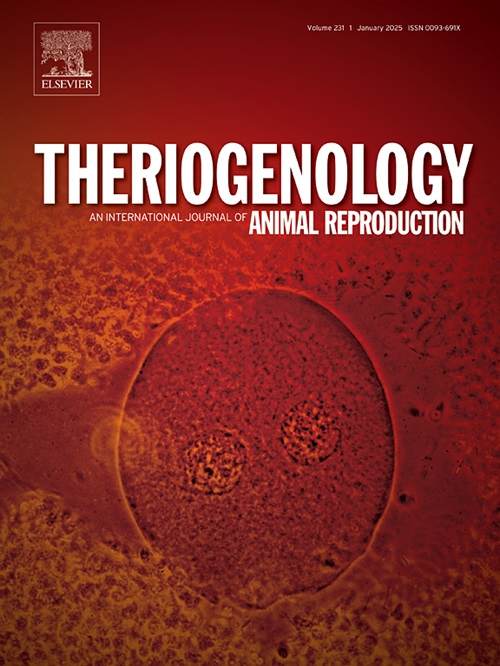Effects of different concentrations of N-acetylcysteine on the sperm quality, antioxidant enzyme activity, and antioxidant gene expression of cryopreserved goat semen
IF 2.4
2区 农林科学
Q3 REPRODUCTIVE BIOLOGY
引用次数: 0
Abstract
During cryopreservation, spermatozoa produce excess reactive oxygen species (ROS), which attack the plasma membrane, disrupt the physiological structure of the sperm, and ultimately decrease semen quality. This study investigated the effects of different N-acetylcysteine (NAC) concentrations on the cryopreservation of semen from Qianbei Ma goats. Semen samples were collected from five bucks with motility rates above 80 %. The treatment groups were diluted 20-fold in extenders containing 3 or 9 mM NAC and cryopreserved in liquid nitrogen, whereas the control group did not include NAC. After thawing, the sperm motility, antioxidant gene expression, enzyme activity, and cell structure were analysed. The NAC-treated groups showed improved post-thaw sperm motility. The 9 mM NAC group presented the highest catalase (CAT) and glutathione peroxidase activities, lowest ROS levels, and fewest apoptotic sperms. Moreover, the 3 mM NAC group presented the highest superoxide dismutase activity and L-cysteine levels and the lowest malondialdehyde levels. Additionally, sperm membrane integrity and mitochondrial membrane potential were significantly higher in the NAC-treated group than that in the control. Further analysis of antioxidant and apoptotic gene expression in the treated sperm revealed that the 9 mM NAC group presented significantly greater CAT and GPX4 expression than the control and 3 mM NAC groups, whereas the apoptotic genes BAX and Caspase3 were elevated in the control group compared to both the NAC groups. In summary, adding NAC to semen extenders enhanced antioxidant gene expression, increased enzyme activity, and improved post-thaw semen quality, with the 9 mM NAC treatment showing the optimal effects.
不同浓度的 N-乙酰半胱氨酸对冷冻山羊精液中精子质量、抗氧化酶活性和抗氧化基因表达的影响
在冷冻保存过程中,精子会产生过量的活性氧(ROS),从而攻击质膜,破坏精子的生理结构,最终降低精液质量。本研究探讨了不同浓度的 N-乙酰半胱氨酸(NAC)对黔北麻山羊精液冷冻保存的影响。研究人员从五只运动率超过 80% 的公山羊身上采集了精液样本。处理组在含有 3 或 9 mM NAC 的扩展剂中稀释 20 倍,并在液氮中冷冻保存,而对照组则不含 NAC。解冻后,对精子活力、抗氧化基因表达、酶活性和细胞结构进行分析。经 NAC 处理的组别在解冻后精子活力有所改善。9 mM NAC组的过氧化氢酶(CAT)和谷胱甘肽过氧化物酶活性最高,ROS水平最低,凋亡精子最少。此外,3 毫摩尔 NAC 组的超氧化物歧化酶活性和 L-半胱氨酸水平最高,丙二醛水平最低。此外,NAC 处理组的精子膜完整性和线粒体膜电位明显高于对照组。对处理精子中抗氧化和凋亡基因表达的进一步分析表明,9 mM NAC 组的 CAT 和 GPX4 表达明显高于对照组和 3 mM NAC 组,而对照组的凋亡基因 BAX 和 Caspase3 则高于 NAC 两组。总之,在精液浓缩剂中添加 NAC 可增强抗氧化基因的表达、提高酶的活性并改善解冻后精液的质量,其中 9 mM NAC 处理的效果最佳。
本文章由计算机程序翻译,如有差异,请以英文原文为准。
求助全文
约1分钟内获得全文
求助全文
来源期刊

Theriogenology
农林科学-生殖生物学
CiteScore
5.50
自引率
14.30%
发文量
387
审稿时长
72 days
期刊介绍:
Theriogenology provides an international forum for researchers, clinicians, and industry professionals in animal reproductive biology. This acclaimed journal publishes articles on a wide range of topics in reproductive and developmental biology, of domestic mammal, avian, and aquatic species as well as wild species which are the object of veterinary care in research or conservation programs.
文献相关原料
公司名称
产品信息
索莱宝
mitochondrial membrane potential assay kit
索莱宝
hypoosmotic swelling solution
 求助内容:
求助内容: 应助结果提醒方式:
应助结果提醒方式:


